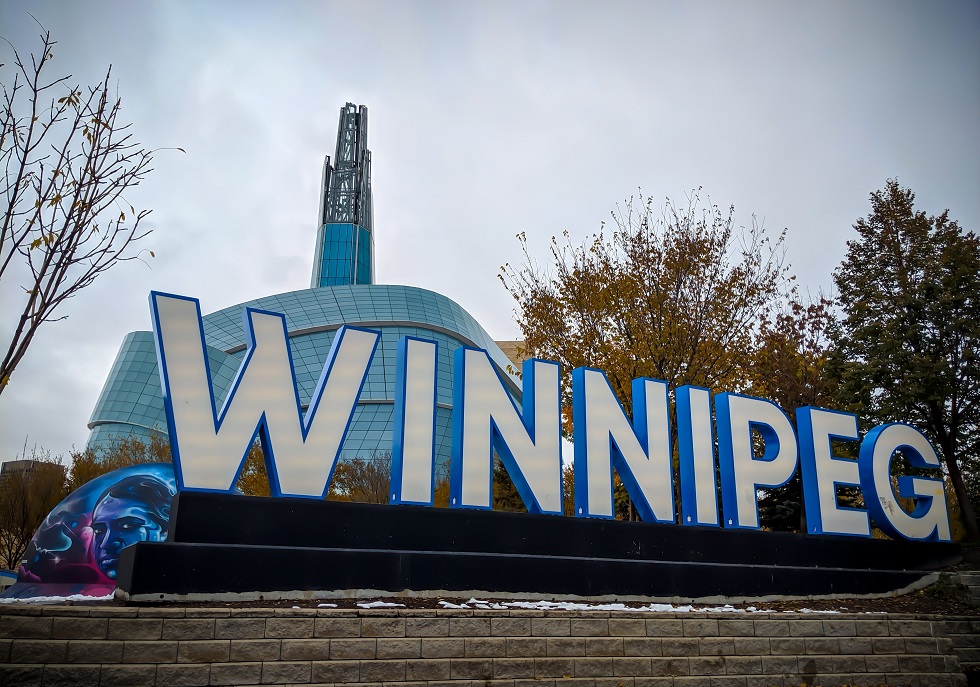Winnipeg is situated equidistant from the Atlantic and Pacific oceans. It lies at the confluence of the Red and Assiniboine Rivers where The Forks (one of the top things to do in Winnipeg recommendations) is the heart of central Canada.
Winnipeg is synonymous with the Winnipeg Jets or the city’s NHL team (hockey nights in Winnipeg are a passionate affair)but there are so many cultural, historical and fun things to do in Winnipeg, whether you’re going with a date or wanting to spend time with your family. From seeing ballet, polar bears and to bisons there are a large variety of activities to partake in.
Winnipeg’s most recent recognition comes from the burning of the St Boniface in the French Quarter and from its major attraction, the impressive Canadian Museum for Human Rights.
With every change in season, the city experiences extremes but that’s what excites people to leave their homes for an adventure. Festivals and activities provide a range of things to do in Winnipeg vary by season. Residents are often called Peggers and this friendly, unassuming Canadian city provides plenty of things for a visitor to do.
Best Things To Do In Winnipeg
Explore French-Canadian Culture and History
Outside of Quebec, Winnipeg has one of the largest French-Canadian populations. Explore this by visiting the neighborhood of St. Boniface from the French Quarter.
Taking a walking tour of St. Boniface runs during summer months, starting at St. Boniface City Hall and ending at the St. Boniface Museum. The museum, open year-round, is housed in the oldest building in Winnipeg, a former Grey Nun’s convent, and profiles Western Canada’s French-Canadian and Métis heritage.
At St. Boniface is Fort Gibraltar which is a reconstructed fur-trade-era fort. In the summer, cosplay actors will recreate fort life from the 1815 period. Each February, re-enactors again bring the past to life when the fort and the surrounding Whittier Park become the center of the 10-day Festival du Voyageur.
Forks National Historic Site
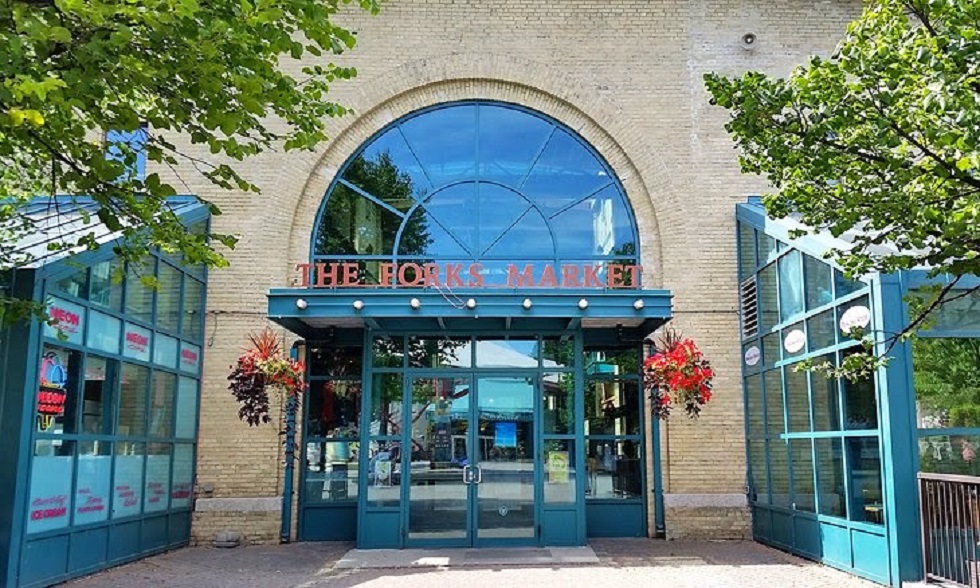
The Forks National Historic Site is where the Red and Assiniboine Rivers join. Over 6000 years the Red and Assiniboine Rivers has long been a gathering place for First Nations tribes.
Located in downtown Winnipeg, Forks is a shopping and entertainment district set in a number of historic buildings.
The Forks Market, where fruit and vegetable sellers set up in the main hall, and food vendors cook up a variety of tasty diverse dishes and pubs amongst tree-lined paths along the river. The market also houses eateries, Head to The Common for a choice of craft beer and wine on tap, curated by sommelier Veronique Rivest.
Stores are found on two levels. Take a delightful stroll up the lookout tower to get a bird’s-eye view over the river and the city. The neighboring four-story Johnston Terminal sells specialty items and souvenirs. When you stroll along the paths, you receive a mini-history lesson from the many informative boards along the way, get a great view of the junction of the rivers from the Forks Historic Rail Bridge and see the prairie garden. Many public entertainment venues hold festivals throughout the year- so you’ll always have something to see wherever you go.
During summers, the Riverwalk is a pleasant walking trail that will take you over to another of Winnipeg’s key attractions: the Legislative Building (mentioned below). One of the most popular things to do in winter is to skate at The Forks ice-skating rink or on the frozen river.
The Forks is popular with families as there are a children’s play area and water park.
In the winter, the Plaza Canopy becomes an artificially cooled skating rink where you can rent skates. The rivers provide more skating on the Guinness World Record-holding longest naturally frozen skating rink in the world!
At the bustling Forks Market, surrounded by outdoor patios, is the Market Plaza and Canopy, the site of open-air performances in the summer.
The Legislative Building: Hermetic Code Tour
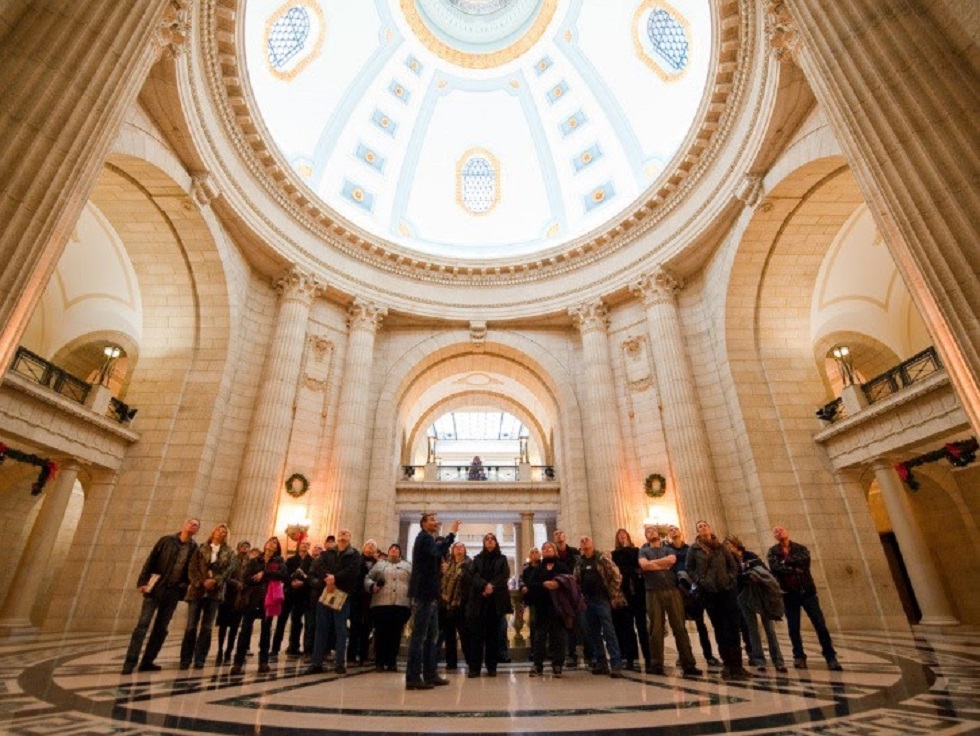
Mystery fans will love trying to decipher the codes hidden in one of Canada’s finest provincial legislative buildings. Built of local Tyndall stone and Italian marble, the magnificent Neoclassical Legislative Building in Winnipeg was completed in 1919. The unique interior of the building includes hidden hieroglyphics, Freemason symbols and codes, and secret numerical codes of which are unveiled during the Hermetic Code Tour.
Atop this building is a Golden Boy, crafted in Paris and holding a sheath of wheat. The decadent grounds feature statues, monuments, and beautifully manicured gardens. Surmounting the 72-meter dome is a statue known as the Golden Boy, a four-meter-high bronze weighing five tons and plated with 23.5 carat gold. A torch in his right hand and sheaf of wheat on his left arm symbolize Manitoba’s enduring agricultural prosperity.
Within the interiors is the Grand Staircase of 39 steps, broken up into three flights of 13. See the special acoustics at the center of the eight-pointed star on the marble floor under the dome of the Rotunda lit by Roman Standard Lamps, each containing 13 bulbs. Inside you can also find statues of goddesses and learn about the rooftop Golden Boy statue representing the Greek god Hermes.
Tours are offered weekly and are led by an architectural historian: Dr. Frank Albo. He enthusiastically points out hieroglyphics, freemason symbols and numeric codes in what he calls a “temple masquerading as a government building” while providing interesting bits of history about the 1920 building.
Canadian Museum For Human Rights
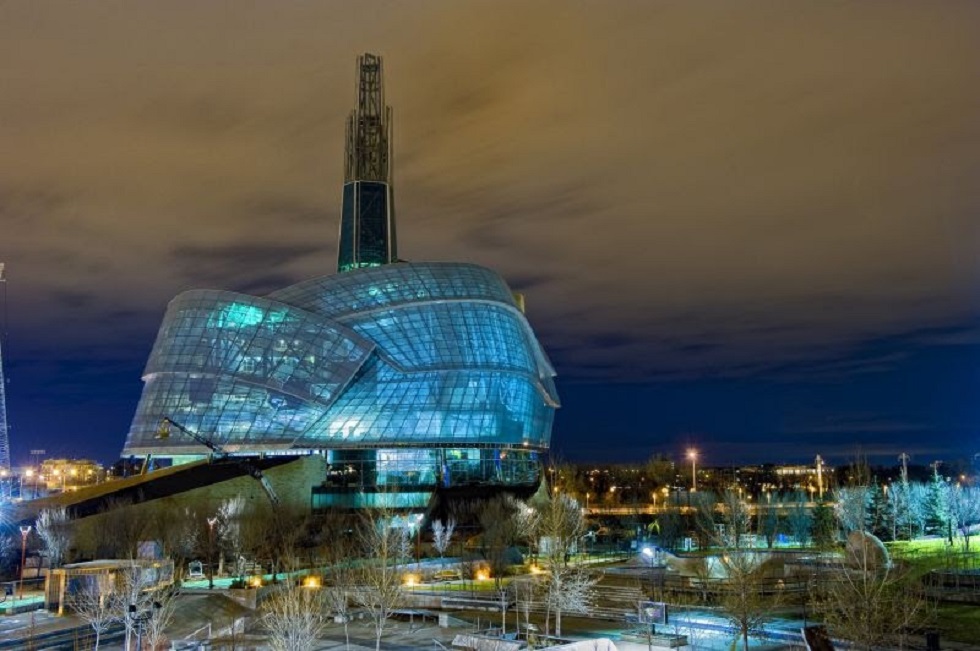
This recently built museum dominates the Winnipeg skyline and is a must see!
The architectural marvel was designed by architect extraordinaire Antione Predock making it Canada’s most eye-catching attraction glitters like a spaceship in the night.
Within the museum you can easily spend the entire day there if you have the time because the interiors are just as captivating as you experience the immersive journey through 11 powerful, interactive and awe-inspiring exhibits. Get in through massive stone roots and proceed through galleries via alabaster-lined ramps in an upward journey of light through darkness. At the top, an observation deck inside the Tower of Hope, a glass spire reaching into the sky, CMHR’s pinnacle and you’ll get a 360-degree view of Winnipeg.
Architecture and multimedia technology continue to explore the meaning and history of human rights in Canada and around the world. The stories of human rights challenges and triumphs encourage inner reflection and provoke discussions among families and loved ones.
Assiniboine Park Zoo.
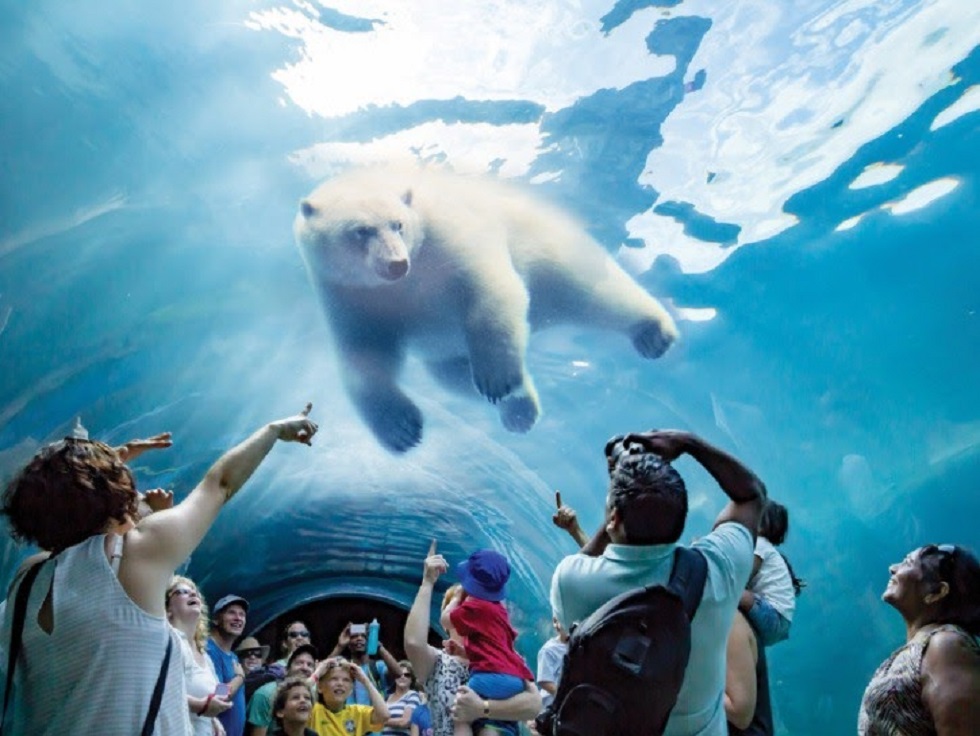
Seeing polar bears at Assiniboine Zoo is one of the things to do in Winnipeg not to be missed. Get up close to polar bears in the wild in Churchill as it’s worth spending time at the Journey to Churchill exhibit in Assiniboine Park Zoo. Watch the bears dive, swim and frolic above you through the exhibit’s glass dome.
Winnipeg’s oldest park, Assiniboine has 445 hectares of grassy lawns and trees, cultural facilities, and an English garden. The Zoo is located within its grounds and is home to a wide variety of flora, and fauna. Amid a landscape of gray tundra rock and low shrubs, visitors find caribou, muskox, snowy owls, and information about the geography and people of the north.
While the polar bears are the main attraction, the zoo also has a decent selection of animals like muskox, wolves, moose and seals, red pandas and snow leopards, along with over 200 other species.
A lot of attention is given to creatures of the northern latitudes, including a significant number of polar bears, though there are also some exotic species such as the Siberian tiger and red kangaroo. Some of the other attractions in the park include the 4-8-2 steam train and the world famous Leo Mol Sculpture Garden for children and for the parents. To the south, a nature reserve adjoins the park.
Kildonan Park
One of the nicest things to do in Winnipeg is to see the Kildonan Park where most ancient trees grow along with splendid flower gardens and a Hänsel and Gretel Witch’s Hut. This park expands over 99 acres and has 2.7 kilometers of recreation trails, much of it running along the Red River. This is an ideal spot for birdwatchers. Kildonan Park is also home to Canada’s longest running open-air theater: Rainbow Stage. Other things to do here include an outdoor swimming pool and golf course.
Ballet
Winnipeg has a world-class ballet company that has been wowing audiences from 1939. The Royal Winnipeg Ballet was the first ballet company to be granted a royal title by Queen Elizabeth II and is the longest continuously operating ballet company in North America.
The Royal Winnipeg Ballet will celebrate their 81st anniversary season in 2020.
Royal Canadian Mint
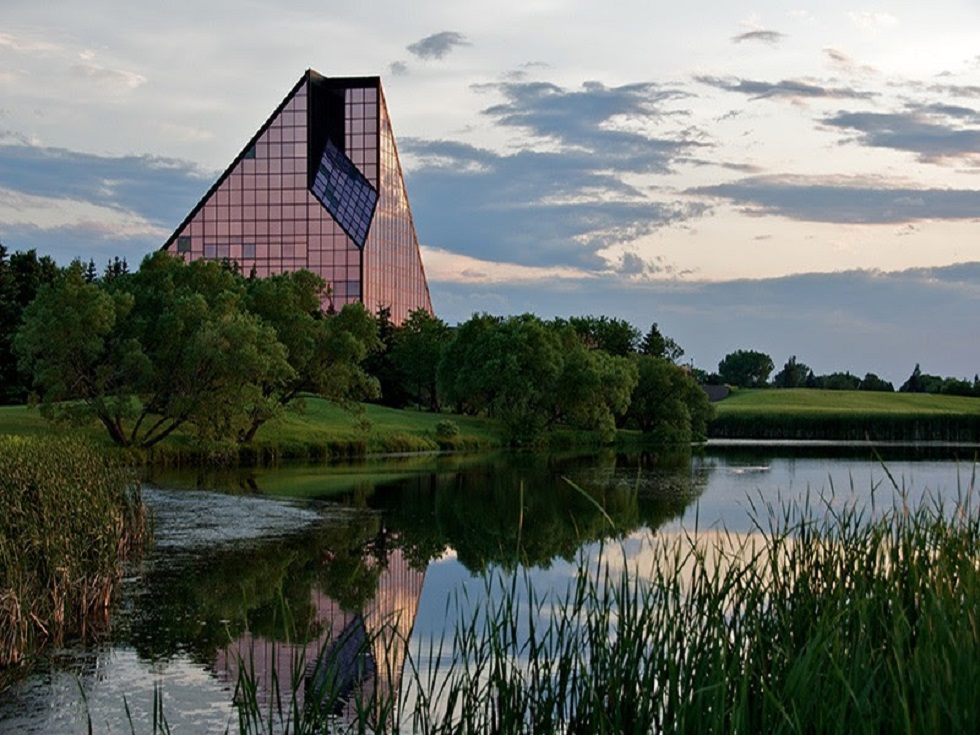
At Winnipeg’s most beautiful buildings, watch the reflective glassy exterior at sundown, glowing under an orange prairie sky.
Inside the Royal Canadian Mint, you’ll find guided tours that will have you holding a $500 thousand gold bar, astonished over the Olympic gold medals that were made for Vancouver 2010, and witness coins being produced for more than 70 different countries.
The Royal Canadian Mint manufacturesa coins not just for Canada, but also for some other countries. In fact, over 55 billion coins have been produced here and you can follow the whole minting process in the recently renovated tour area. Many displays paint the story of how coins are manufactured from start to finish. The on-site museum does an excellent job of showing visitors the ancient history of how coins and currency first started. The uber modern looking triangular-shaped building even comprises a tropical garden and fountain. Reservations for the 45-minute tours are recommended.
9. Take a Bison Safari
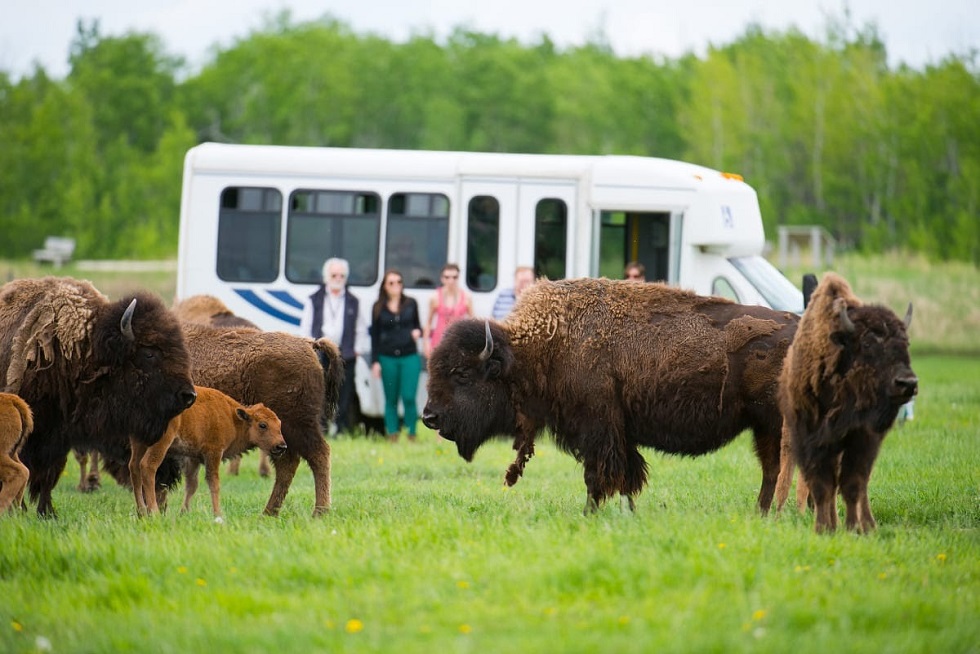
Situated in a beautiful natural setting of prairie, forest, wetlands, and sheltered lakes, FortWhyte Alive is a sight to behold. It has 250ha of pristine prairie south of the city and a destination for all seasons outdoor adventures, environmental education, and exhibits interpreting Manitoba’s cultural and natural history. FortWhyte Alive is very popular for its herd of 30 bison.
In the summer, feel the wind in your hair as you sail on one of Fortwhyte’s several lakes. This is great for a family holiday.
During fall, enjoy locally brewed beer on the restaurant patio while watching North America’s largest animal (the bison) roam in its natural habitat as migrating birds fill the sky.
In the snowy season, you can go cross-country skiing on its many trails, or take the kids out for a ridiculously fun day of sliding on the Richardson Run Toboggan slide.
If you want more than a far-off glimpse, take one of the weekly Bison Safaris for an up-close encounter with North America’s largest land mammals. If you’d like to add powering a voyageur canoe, exploring a tipi, and enjoying tea and bannock over a campfire to your up-close encounter, take the longer Prairie Legacy: The Bison and Its People tour. Relax and visit the rest of the nature preserve before or after your tour.
10. Manitoba Museum
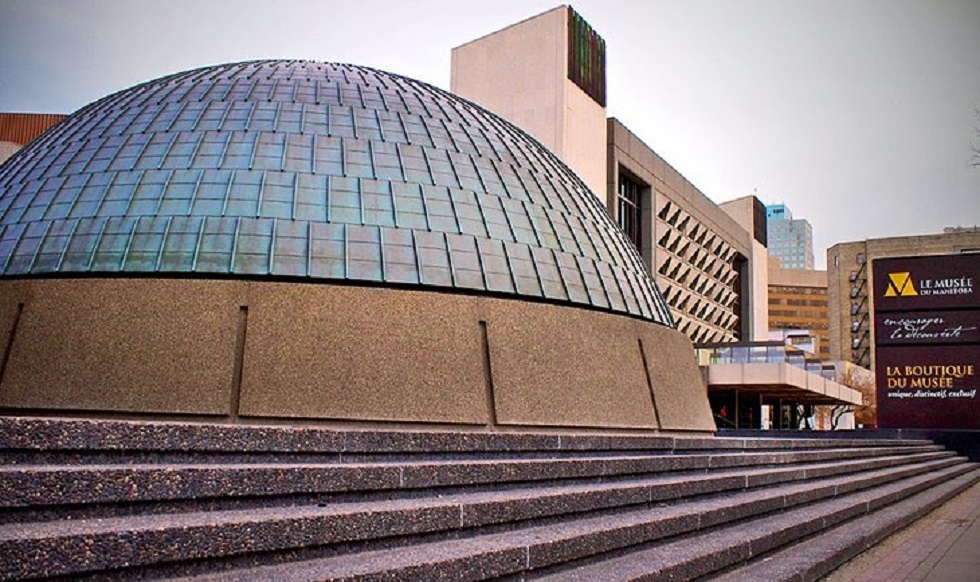
The amazing Manitoba Museum is located downtown, not far from the Exchange District. It explores the interactions of people with their environment. Visiting the museums is also a fun thing to do in Winnipeg for the whole family and you can make a day of it by heading to the Exchange for food later.
This museum comprises of nine permanent galleries to showcase the best of what the province has to offer, and the highly interactive Science Gallery and Planetarium which introduces the vastness of the night sky on its domed screen.
Exhibits in the Arctic/Sub-Arctic, Boreal Forest, Parklands, and Grasslands galleries showcase the human and natural history of these areas. Other galleries recreate the 1920 streets of Winnipeg and highlight the history of the Hudson’s Bay Company which was the corporation that made the largest impact on the history of Canada for its fur trading post. At the Nonsuch Gallery, you’ll find a full-size replica of a 1600s merchant ship and remains a perennial favorite.
Manitoba Museum’s galleries are packed with history and educational displays: see the giant dinosaurs of the Cretaceous Period and across the cosmos through space and time to the buffalo laden prairie plains.
Witness the Planetarium show, equipped with a sophisticated projection system or catch the story behind Canada’s most important historical artefacts in the Hudson’s Bay Company Museum Collection. The Manitoba Museum has done a wonderful job with their displays.
The best part of the museum is the 95-million-year-old Pliosaur fossil, a display that recreates the Northern Lights. One of the most famous exhibits is the Nonsuch, a 17th-century replica ketch sailing ship. You can climb on board and explore all areas of the ship to see the hardships of the brave souls that crossed the Atlantic back in the day.
11. Fort Whyte Alive
Across 259 hectares, Fort Whyte Alive is popular for its five lakes, grassy parkland, and bog boardwalks. It is an interpretive center which houses an aquarium and nature exhibits, including burrowing owls. On the outside, you can watch the bison herd, visit the bird-feeding stations, witness the sod house, or watch the antics of the prairie dogs at the prairie dog town.
This center is sure to get you active with its seven kilometers of walking and cycling trails, and sailing and paddling courses are taught in the summer on the small lakes. During the winters, a giant ice-skating rink, toboggan run, and cross-country ski trails are available for those who love snow and enjoy the cooler temperatures.
12. Prairie Dog Central Railway
The Prairie Dog Central is a fully restored, steam-powered locomotive offering trips from Winnipeg to Grosse Isle. The steam train has vintage coaches, which carry visitors on an hour and 15 minutes including a stopover before returning to Winnipeg. A variety of themed excursions are possible here including train robberies, halloween events, and more.
13. The Exchange District
Explore the quirky history of the area on one of the Exchange District walking tours.
The Exchange District is a 30-block area in central Winnipeg, home to colourful local restaurants, boutique shops, and art galleries. But it’s the turn of the century buildings that stand out. This site has a large collection of heritage buildings still existing from 1880 to 1920, when Winnipeg was known as “Gateway to the West” and “Chicago of the North.”
Starting as early as 1880, Victorian and Edwardian commercial architecture defines Winnipeg’s Exchange District, its name: “the exchange” a reflection of the many financial institutions that sprung up in Winnipeg between the 1880s and 1920s.
More recently, the Exchange District has seen a revival with old warehouses, banks, and business premises being converted into fashion boutiques, up-market shops, art galleries, bistros, galleries, antique shops and some of the best the city has to offer in coffee and cafés. You can also witness the many ghost signs,fading painted advertisements from days gone by, still visible on the brick and stone buildings.
Why is it called the exchange?
Did you know that Winnipeg used to be the third richest city in Canada and a significant centre for grain? The grain exchange brought the Canadian Pacific Railway and mass migration to the Prairies.
A great way to see the Canadian countryside is to board Via Rail’s The Canadian, the Trans-Canadian railway, which connects Toronto to Vancouver and stops in Winnipeg.
The revamping of Winnipeg’s Exchange District began with using the old buildings where historic stone warehouses are being filled with workshops, pop-up stores, restaurants, nightclubs and art galleries.
The first Friday evening of each month is for artists in the area to open their studios to the public. Old Market Square is the unofficial heart of the area and the site of various events, open-air concerts and festivals in the summer months.
For `Food: The Exchange offers world-class dining experiences in some of the city’s best restaurants.
For Culture: The Exchange District is also a focus for the city’s cultural life, with an impressive selection of venues including the Pantages Playhouse Theatre, Royal Manitoba Theatre Centre, and Manitoba Centennial Centre.
14. Craft Breweries
Winnipeg’s craft brewery scene is one of the things you have to do in Winnipeg because it is thriving! With many craft breweries, taprooms, and a couple of brewpubs with restaurants, you can make a day out of drinking the beer that you love and enjoy a fun way to see the city at night and meet some friendly locals.
There are tours that can take you to several microbreweries for sampling and a behind-the-scenes look to discover the secrets of making great beer. Many microbreweries offer wood-fired pizza and tasting paddles with plenty of beer.
15. Manitoba Children’s Museum
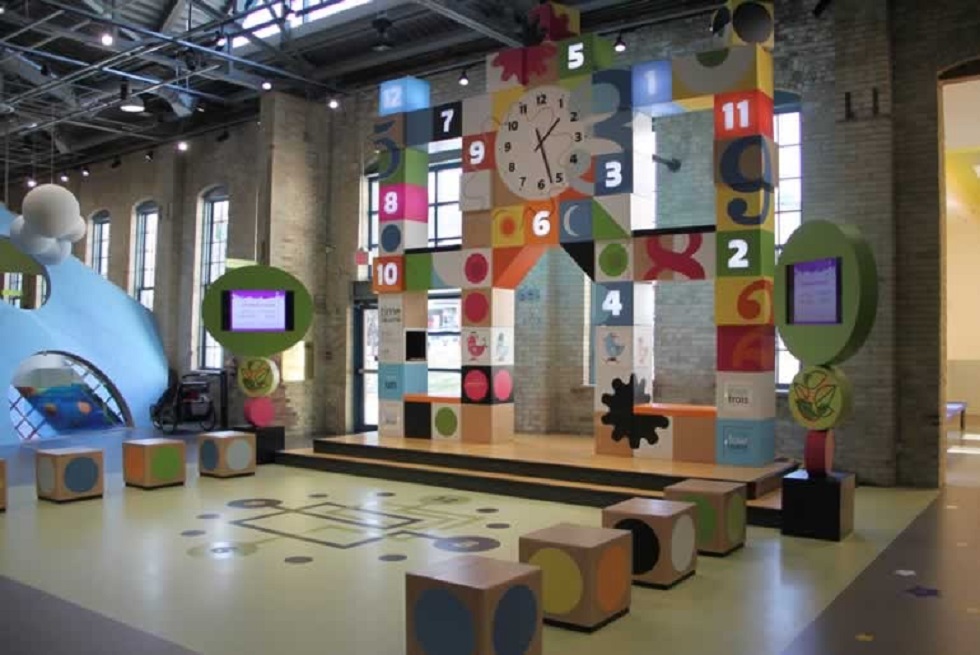
The Manitoba Children’s Museum is located in a state-of-the-art facility within The Forks. The unique interiors of this building has 12 interactive permanent galleries, which will appeal to children of all ages.
These galleries can range from the Milk Machine, featuring a giant cow cube you can actually go inside, to the Engine House, where kids will find an array of cogs, gears and levers to pull. Another interesting sight is the Lasagna Lookout, where your kids are allowed to play with their food and you don’t have to clean up after!
In addition to the 12 permanent galleries, the Manitoba Children’s Museum also has traveling exhibits and special performances and festivals around key dates like Halloween and Christmas.
16. Festival du Voyageur
Festival du Voyageur is Winnipeg’s most popular winter festival. Each February, this event celebrates the traditions of the French Voyageurs who were the fur traders of early Canada. Festival du Voyageur includes entertainment and events for children and adults, with activities in French and English. Large tents are set up outdoors at Voyageur Park and other
sites in the city, where you can find live music, food, dancing, and more.
Do visit the stunning ice and snow sculptures, one of the highlights of the festival. Another festival tradition is the beard-growing contest, for which participants have 10 weeks prior to the festival to grow their best beard in four categories.
